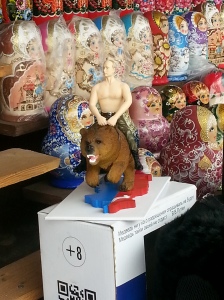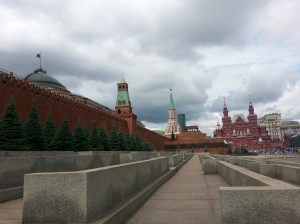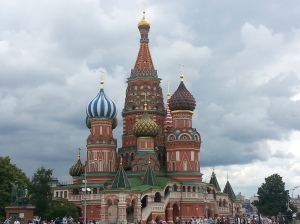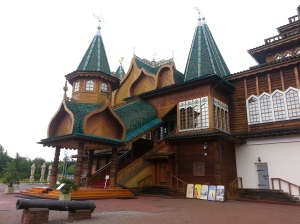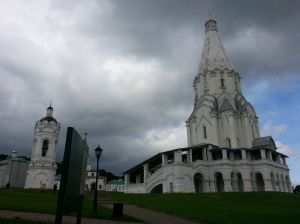Author’s Disclaimer: This post is very long compared to my past posts. I felt it to be simpler to just put everything into one post rather than break it into parts. It’s less navigating and clicking for you, and less pages and editing for me. Feel free to take breaks; just remember where you left off and come back to visit.
Friday July 10, 2015- Time to go to Moscow! I went to bed at about 1:00 or 2:00 in the morning for a 5:00 wake-up, intending on sleeping during the four hour train ride from St. Petersburg to Moscow. No major bumps in the road occurred; I woke-up on time, left for the train station on time, and I went right to sleep once the train started rolling. The only discrepancy is I thought the train was a bullet train that went like 300 MPH, but it wasn’t. The train was rather advanced, and its interior was reminiscent of an upscale airplane. Nonetheless, it got the job done of keeping me asleep the entire train ride.
Once I woke-up, I was in Moscow. Right from the arrival, Moscow seemed like an entirely different place than St. Petersburg. There were a lot more people, which was also more diverse in race and ethnicity, and a lot more vehicle traffic. There were more buildings which were much taller, and also a lot more construction. Most of all, the Soviet past still manifests itself much more in Moscow than St. Petersburg, especially through architecture. Everywhere one looks, they find a ghost of Soviet past like a monument, architectural style, street names, or a star or sickle and hammer etched in walls and ceilings.
One of the two big events today was a short bus tour of the city prior to checking into the hotel. The highlight of the bus tour was driving by Red Square, the Kremlin, and St. Basil’s Cathedral. This area is one I’ve dreamed of visiting since I was a boy. This entire trip is nearly worth it just to visit this one site. We drove past it today, and will visit it tomorrow. Another feature of the tour was a stop at a Novodevichy Cemetery, the cemetery for many important and influential people in Russian history. This is important to me because we saw the grave for Soviet leader Nikita Khrushchev. His grave was rather interesting containing a scramble of shapes colored black or white, the artist’s elaboration of Khrushchev’s good and bad qualities.
After checking into the hotel and eating lunch, most of the group went to a souvenir plaza not far from the hotel. Another characteristic of Moscow is it seems like more Russians know how to speak in English, which was very apparent from the bartering shopkeepers. It was difficult to look around because any time one of us stopped to look at something, the shopkeeper immediately began trying to sell the item by haggling prices and make deals. This was problematic because most of us, me included, just wanted to look but not buy since we would have opportunities later in the weekend. Most of us cracked and bought something, myself included again. One girl in our group said that even though she was happy with her purchase, she felt rushed and pressured to buy. I bought two 5-piece matryoshka dolls, one a UGA football set and a 1972 Soviet hockey team set. I was most interested in the UGA set, finding it surprising to find in Moscow. The shopkeeper had other popular college and sports team dolls. I asked him about how he knows about the teams, and he said that he has contact in the US and uses the internet to make dolls more marketable to tourists. He claimed the UGA set was his only one of the kind on hand, and I was concerned that one of my groupmates would get it if I didn’t. He gave me a “deal” of both dolls for 2000 rubles total, or about $40. There were tons of stuff I liked and I also need to pick-up a few gifts for my friends and family, so I look forward to going back soon.
The second big event today was the Moscow Circus. The circus was alright; not as good as ‘Swan Lake’ and the Cossack Folk Show, but still something to do to end the day productively. One of the biggest factors was unlike ‘Swan Lake’ and the Cossack Folk Show, my seats for the circus were not that great and inhibited me from enjoying the circus as much as others. My view was constantly blocked by a pillar, one of the spotlights, and people traffic moving back and forth from their seats. The circus primarily used acrobatics and animals. The acrobatics were enjoyable, but not comparable to acts I have seen before like Cirque de Soleil. I was also discouraged about the use of animals. I do not know what it is, but seeing exotic animals like lions, tigers, and chimpanzees take orders from a human from their voice or a touch of a stick does not compare to seeing the animals closer to their natural living like in the zoo or in the wild. I have no idea how the animals were trained and how they are maintained show to show. But I would rather pay money to see the same animals living in their natural habit and not performing tricks, rather than worry about safety and well-being of the animals in captivity used as entertainment.
Saturday July 11, 2015- Today is the day I most anticipated- Red Square. The phrases Red Square and The Kremlin work interchangeably in reference to the literal capital of Russia, like using ‘The White House’, ‘The Oval Office’, ‘Washington’, etc. in an American sense. Specifically though, the Kremlin was initially a fort settled along the Moscow River in 1495. It was actually very common during the formation of Slavic city-states to build kremlins in which many exist to this day. The Kremlin today houses the Grand Kremlin Palace where Soviet leadership in the past and Russian presidents of the present live and work.
Likewise, Red Square refers to a communal space shared by the Kremlin, St. Basil’s Cathedral, the State Museum of Russian History, and the open area in between the buildings. Contrary to belief, the name Red Square bears no reference to the Soviet Union or Communist Party, and the name is actually much older. The Russian word for ‘red’ sounds similar to the word for ‘beautiful’ because Russians have historically seen red as the most beautiful color of all. When I’ve talked to Russians that have spoken in English, some have incorrectly used the word “red” when meaning to say “beautiful” because of the relationship between the two words in Russian. Russians have used the phrase Red Square to refer to describe the beautiful space where they exchanged commerce, governed laws, protected citizens, and practiced religion. It also helped that deep red colored bricks formed the outer, physical appearance of most building located in and around Red Square. The Soviet Union merely adopted the heavy usage of “red” in its verbiage and art.
Speaking of the Soviet Union, the first stop on Red Square was Lenin’s Mausoleum. For those that do not know, the Soviet Union has preserved and displayed Vladimir Lenin’s body since his death in 1924. The line to the mausoleum was anxiously long. The path through the mausoleum followed a labyrinth of stairs through dimmed lighting. But once in the main room, his body appeared in a glass case laminated by a rose tinted lamp from above. The his revolution is in the past and the country he founded may no longer exist, but his body still remains under constant maintenance, guard, and marveled attraction over 91 years later. The gift keeps on giving when on the way out of Lenin’s Mausoleum, one follows a row of the graves of many prominent Russian leaders and heroes. Two of particular interest were Leonid Brezhnev and Josef Stalin. I feel satisfied that I have seen the graves of all deceased Soviet leaders during this one excursion to Moscow. The history that I love to study and teach really came alive at the sight of Lenin’s and Stalin’s resting places.
Next on the menu was St. Basil’s Cathedral. The cathedral is one of the most recognizable buildings on earth if not by name then by association with Moscow and/or Russia. The cathedral served orthodox purposes since its construction in 1561. Starting in 1928, the cathedral operated as museum to the decree of the Soviet Union, which it continues to do today. The inside of the cathedral contains many of the same features as other cathedrals and churches I’ve visited thus far. However St. Basil’s cathedral is relatively unaltered and walking through its halls and chambers is like taking a walk through feudal history.
After the Kremlin tour, the group split into a party that went to Victory Park and another, which included me, to the State Historical Museum. I really wish I could have gone to Victory Park, but I felt I would get more benefit out of the museum. The museum was constructed in 1883 and contains exhibits that surveys the Russian landscape from ancient humanoids to the late 19th century. I really enjoyed this museum because I have been immersed in Russian history from 1700 to the present ever since arriving two weeks ago. The museum helped cover Russian history before 1700, especially mentioning ancient nomads and early settlers, pre-Christianity, and Mongol occupation.
Nighttime fell on Moscow once the museum tour concluded. This was remarkable first because I have been acclimated to the White Nights of St. Petersburg, and Moscow produced darker nights in comparison to St. Petersburg’s due to its more southern latitude further away from the Arctic Circle. The second remarkable aspect of Moscow’s night was the white Christmas-like lights that illuminated the buildings that composed Red Square. It was reminiscent of Christmas in July, but better than Georgia at this time of year. I had illuminated buildings and stars, cooler weather, and Christmas dream come true.
Sunday July 12, 2015- The majority of our last stay in Moscow was spent at the settlement of Kolomenskoye. The origin of Kolomenskoye dates back to at least the 14th century as a village on top of a steep hill overseeing the Moscow River. The village became a favorite spot for the royal family and still bears original and replica buildings dedicated to the tsars that considered Kolomenskoye one of many homes.
Landmarks we visited at Kolomenskoye include:
-Replica of the Wooden Palace: A recreation of the palace constructed for Tsar Alexi I in which his successors like Peter the Great and Elizabeth I grew-up.
-Church of John the Baptist in Dyakovo: An original church constructed in 1547 by the architect of St. Basil’s Cathedral Postnik Yakovlev.
-Church of the Ascension: A tall, white church built in 1532 more characteristic to Russian, not Byzantine tradition.
-Church of St. George: A church still in religious use which was having service when we visited Kolomenskoye.
-Church of Our Lady of Kazan: Another original church that serves as a place of worship and tourist attraction. I couldn’t go in because I was wearing shorts.
In between the Kolomenskoye excursion and train ride back to St. Petersburg, we spent a few hours shopping in the same souvenir market as Friday. I went into the market with an idea of what I already wanted. I saw a few recognizable shopkeepers who fortunately remembered me. They also welcomed and appreciated my consistent patronage. Just out of my curiosity to learn about Russians, I tried to make some small talk with the shopkeepers I bought from. Unlike Friday when the shopkeepers redirected back to their goods to make a sell, the shopkeepers talked much more this time around. We talked about personal experiences; where were these people from, what have they done in the past, what do they do when they’re not running their souvenir shops? Maybe they were just giving me the tourist experience, but I think they were genuine. I think they valued my loyalty to visit their shops and curiosity to hear their stories, and the reciprocated with telling me at least something which is better than nothing at all. I can remember the face and story of the prior owner when I look at each of my purchased items. Many stories, handshakes, and hugs were ultimately shared today.
After shopping, it was da svidaniya Moscow. Like this entire experience, the excursion to Moscow went by quick and seemed too short. However, I am looking forward to going back to St. Petersburg. I like Moscow, but I like St. Petersburg more in comparison. This is against my preconceived notions going into the trip when I was looking more forward to Moscow than I was St. Petersburg. But either way, they were both meaningful and memorable experiences I will take back with me when I go home in two, very short weeks.


